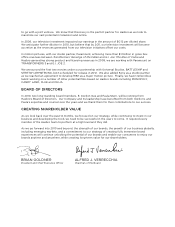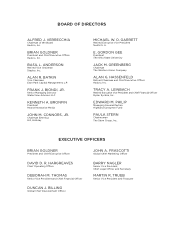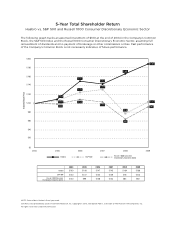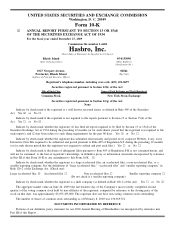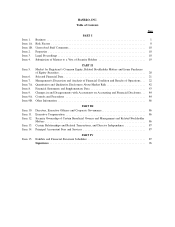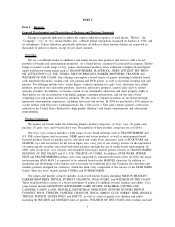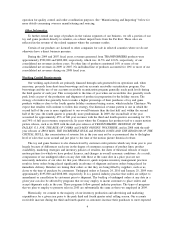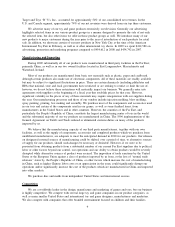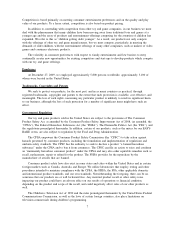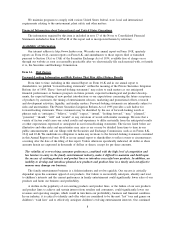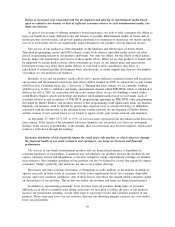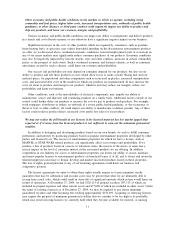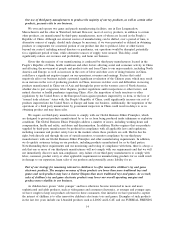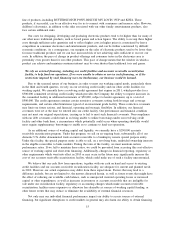Hasbro 2009 Annual Report Download - page 16
Download and view the complete annual report
Please find page 16 of the 2009 Hasbro annual report below. You can navigate through the pages in the report by either clicking on the pages listed below, or by using the keyword search tool below to find specific information within the annual report.
Target and Toys “R” Us, Inc., accounted for approximately 54% of our consolidated net revenues. In the
U.S. and Canada segment, approximately 74% of our net revenues were derived from our top three customers.
We advertise many of our toy and game products extensively on television. Generally our advertising
highlights selected items in our various product groups in a manner designed to promote the sale of not only
the selected item, but also other items we offer in those product groups as well. We introduce many of our
new products to major customers during the year prior to the year of introduction of such products for retail
sale. In addition, we showcase certain of our new products in New York City at the time of the American
International Toy Fair in February, as well as at other international toy shows. In 2009 we spent $412,580 on
advertising, promotion and marketing programs compared to $454,612 in 2008 and $434,742 in 2007.
Manufacturing and Importing
During 2009 substantially all of our products were manufactured in third party facilities in the Far East,
primarily China, as well as in our two owned facilities located in East Longmeadow, Massachusetts and
Waterford, Ireland.
Most of our products are manufactured from basic raw materials such as plastic, paper and cardboard,
although certain products also make use of electronic components. All of these materials are readily available
but may be subject to significant fluctuations in price. There are certain chemicals (including phthalates and
BPA) that national, state and local governments have restricted or are seeking to restrict or limit the use of;
however, we do not believe these restrictions will materially impact our business. We generally enter into
agreements with suppliers at the beginning of a fiscal year that establish prices for that year. However,
significant volatility in the prices of any of these materials may require renegotiation with our suppliers during
the year. Our manufacturing processes and those of our vendors include injection molding, blow molding,
spray painting, printing, box making and assembly. We purchase most of the components and accessories used
in our toys and certain of the components used in our games, as well as some finished items, from
manufacturers in the United States and in other countries. However, the countries of the Far East, and
particularly the People’s Republic of China, constitute the largest manufacturing center of toys in the world
and the substantial majority of our toy products are manufactured in China. The 1996 implementation of the
General Agreement on Tariffs and Trade reduced or eliminated customs duties on many of the products
imported by us.
We believe that the manufacturing capacity of our third party manufacturers, together with our own
facilities, as well as the supply of components, accessories and completed products which we purchase from
unaffiliated manufacturers, are adequate to meet the anticipated demand in 2010 for our products. Our reliance
on designated external sources of manufacturing could be shifted, over a period of time, to alternative sources
of supply for our products, should such changes be necessary or desirable. However, if we were to be
prevented from obtaining products from a substantial number of our current Far East suppliers due to political,
labor or other factors beyond our control, our operations and our ability to obtain products would be severely
disrupted while alternative sources of product were secured. The imposition of trade sanctions by the United
States or the European Union against a class of products imported by us from, or the loss of “normal trade
relations” status by, the People’s Republic of China, or other factors which increase the cost of manufacturing
in China, such as higher Chinese labor costs or an appreciation in the yuan, could significantly disrupt our
operations and/or significantly increase the cost of the products which are manufactured in China and imported
into other markets.
We purchase dies and molds from independent United States and international sources.
Competition
We are a worldwide leader in the design, manufacture and marketing of games and toys, but our business
is highly competitive. We compete with several large toy and game companies in our product categories, as
well as many smaller United States and international toy and game designers, manufacturers and marketers.
We also compete with companies that offer branded entertainment focused on children and their families.
6


